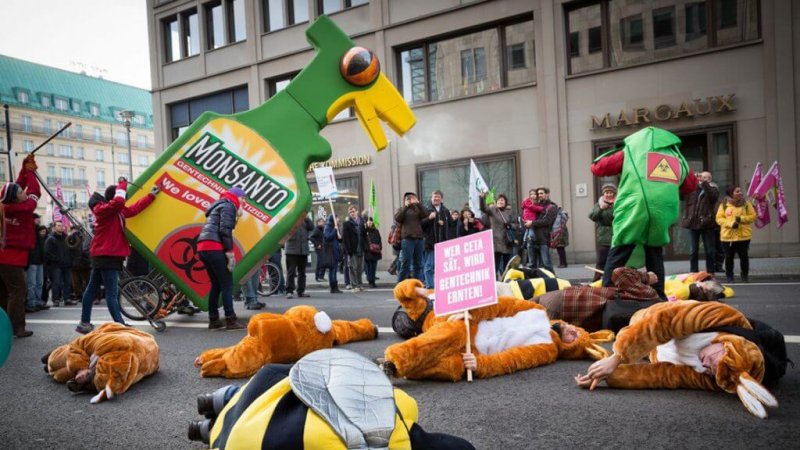The glyphosate controversy shifted to a new forum this week: The House Science and Technology Committee. As might be expected, it was a highly political and ideological airing, illustrating the sharp differences among scientists, industry groups, regulators and politicians over the controversial herbicide glyphosate, sold exclusively until 2000 by Monsanto under its patent name Roundup, but now widely available in generic form from many suppliers.
The National Institutes of Health’s grant database shows that it gave IARC more than $1.2 million last year and more than $48 million since its inception.
“There are real repercussions to IARC’s unsubstantiated claims, which are not backed by reliable data,” Smith, the Texas Republican, said.
Almost all of the Republicans and all but one of the scientists and regulators called to testify were critical of IARC—its funding and transparency. Pushing back were the Democratic committee members and Jennifer Sass, senior scientist for the Natural Resources Defense Council who is on the record declaring glyphosate dangerous and defending IARC’s credibility.
“This hearing is about the ability of a public health agency to call a carcinogen a carcinogen, even if it makes a huge amount of money for a powerful corporation,” said Sass in response. Records compiled by the watchdog group Center for Responsive Politics show Monsanto spent more than $4.3 million in lobbying during 2017.
Much of Sass’s testimony focused on defending IARC’s methodology and on the shortcomings of a separate review released in December of glyphosate by the Environmental Protection Agency, which concluded is unlikely to cause cancer in workers or in those who consume micro traces of it through food.
Rep. Smith said his committee has interviewed a cross section of scientists and regulators who have serious concerns about a lack of transparency within the agency. Sass countered: “The meetings are open and IARC observers are invited. Monsanto was present. Other regulatory interests can also be present. So, they’re public in that sense that anybody who wants to be present can.”
Democrats on the committee pushed back at the GOP’s characterizations of IARC and tried to turn the tables against Monsanto, which has been pushing against the 2015 finding through numerous means.
“It is important that we review the methods and tactics that industry has used to influence this [Trump] administration and attack independent scientific organizations like the World Health Organization’s International Agency for Research on Cancer,” said Oregon Republican representative Suzanne Bonamici.
What was really going on at the hearing?

IARC, based in Lyon, France, is a semi-autonomous sub-division of the World Health Organization. It assesses what is known as cancer “hazard” — whether a substance could cause cancer, not whether it is likely to cause cancer under real world conditions. Many common substances and activities that are perfectly safe when used or consumed in moderation, such as working the night shift, eating processed meat, staying out in the sun, coffee, alcohol — and glyphosate — have all been declared as possible carcinogens by IARC. No other science research agency uses hazard classification; regulatory agencies assess risk — the chances that a person could get cancer under real-world conditions.
It’s this hazard-risk difference that is at the heart of the science part of the dispute. Most scientists and almost every regulatory agency embraces the risk standard as most appropriate; many activists and a very few regulatory agencies use a precautionary hazard standard. For instance, California has cancer warning signs at DisneyWorld park and is proposing adding them to coffee–and to glyphosate.
The issue of whether glyphosate poses any human health hazards took second fiddle to the driving theme of the hearings: what role should industry play in science innovation. Much of the research in modern agriculture is driven by large corporations including Monsanto. That’s mostly because of the high costs of getting new products approved. It’s estimated that a genetically engineered crop can take more than 7 years and well over $100 million to gain approval.
Another key theme running through this dispute — the more political dimension — is the involvement of agribusinesses playing a major role in the testing of their own products. That’s mandated by the US regulatory agencies because of the high cost of testing, which the government does not want taxpayers to assume. The data must be independently derived however, and is often supplemented by independent tests. But any corporate involvement is an anathema to activist groups. They claim companies will go to any length, legal or not, to protect a profitable product.
Sass referred numerous times to the “tobacco-industry tactics applied to glyphosate, and the agrochemical industry attack on the IARC Monographs. “Because of its scientific excellence and its scientific and regulatory relevance, IARC enjoys overwhelming support from the global scientific and medical community,” she said.
That’s not true. In the science world, there is no partisan divide over whether glyphosate, widely considered one of the most effective and mildest herbicides in use today, poses any serious health dangers. The December EPA report—whose conclusions confirmed a preliminary study first released under the Obama Administration—concurs with the findings of every major independent science organization in the world, except for IARC.
The draft human health risk assessment concludes that glyphosate is not likely to be carcinogenic to humans. The Agency’s assessment found no other meaningful risks to human health when the product is used according to the pesticide label. The Agency’s scientific findings are consistent with the conclusions of science reviews by a number of other countries as well as the 2017 National Institute of Health Agricultural Health Survey.
An outlier in the science world, IARC is also facing a credibility crisis—revelations that have led numerous independent scientists to suggest the WHO sub-group uses out-dated methodology, has become ‘captured’ by activists groups and has outlived its usefulness.
Monsanto Papers
Without IARC’s contested findings, the case to ban glyphosate, which hinders the development of genetically modified crops, would collapse. The lynchpin of the activist case against these tools of modern agriculture is the charge that biotech companies and government regulators lie about how dangerous they are.
This is a serious allegation to level against the scientific community, so the anti-GMO movement needs solid evidence to substantiate such 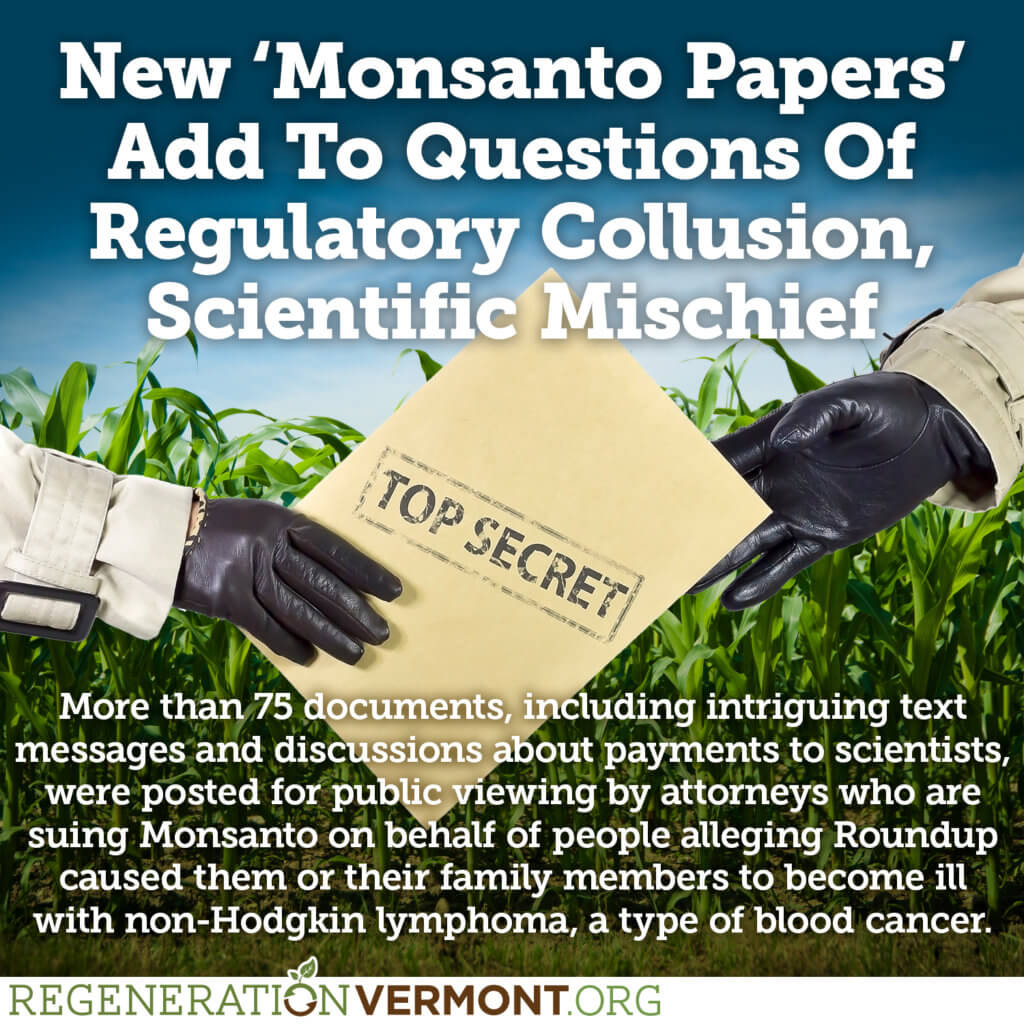 attacks on biotech firms, universities and the scientists they employ. To that end, U.S. Right to Know (USRTK), a California-based anti-GMO activist group whose charter is to challenge agricultural biotechnology, released a cache of internal Monsanto documents two years ago that they dubbed “The Monsanto Papers.”
attacks on biotech firms, universities and the scientists they employ. To that end, U.S. Right to Know (USRTK), a California-based anti-GMO activist group whose charter is to challenge agricultural biotechnology, released a cache of internal Monsanto documents two years ago that they dubbed “The Monsanto Papers.”
In 2015, USRTK began working alongside a team of trial lawyers who are suing Monsanto, alleging that glyphosate, the active ingredient in the company’s herbicide Roundup, causes non-Hodgkin lymphoma (NHL), a very common type of cancer in the United States. In its findings IARC identified NHL as the one type of cancer glyphosate could cause.
The Monsanto Papers is the centerpiece of the 320 lawsuits pending against the biotech firm in San Francisco and its become the activist go-to documents, used all around the world by agricultural biotechnology opponents.. Most of the documents deal with legal procedure and, frankly, they’re boring to read. But a handful discuss the relevant scientific topics, with selected studies touted by the litigants as “proof” that glyphosate is carcinogenic. It’s these that USRTK, Sass and others have misconstrued as evidence of malfeasance on Monsanto’s part.
According to USRTK’s Director of Research Carey Gillam, the “secret conversations” contained in these company emails, court records and other documents reveal that Monsanto officials knew its herbicide Roundup was carcinogenic. Moreover, Gilliam said, the company covered up the risks by trying “to improperly influence” government regulators who are responsible for protecting the public from dangerous chemicals.
These themes were echoed in the Congressional hearings by Sass, the scientist from the Natural Resources Defense Fund. “There is an unprecedented effort largely supported and funded by a coordinated group of industry supporters of glyphosate and other chemicals,” she said. “Fundamentally, this is about whether a science organization can be independent enough to challenge the safety of a substance if that challenges the financial health of that company.”
Such comments, which draw on the narrative established in The Monsanto Papers, are clever marketing. But is that what the ‘Monsanto Papers’ actually illustrate? Do they contain evidence of corporate wrongdoing, as Sass, USRTK and other activist groups claim?
Does glyphosate cause cancer? Examining IARC’s claims
Reading USRTK’s commentary on the Monsanto papers, you might think the documents contain clear evidence that glyphosate is carcinogenic. After all, if the herbicide is safe to use, the conspiracy theory falls apart because there’s nothing for Monsanto to conceal. Unfortunately for USRTK, many of the studies they cite as ‘proving’ glyphosate is carcinogenic are poorly-designed and have been refuted many times over by independent experts.
The 2015 IARC monograph is the centerpiece. Discussing the monograph, the plaintiff’s lawyers wrote, “Scientists … who are renowned and respected experts in their field, systematically reviewed the published and peer-reviewed data and concluded, based on sound, reliable evidence, that glyphosate is a probable human carcinogen.” (p 9)
But those conclusions have been challenged by many independent science organizations around the world. In the congressional hearing, Dr. Robert Tarone, a retired mathematical statistician formerly with the US National Cancer and Biostatistics Director at the International Epidemiology Institute, blasted IARC for its sloppy methodology, out of sync, he said with risk assessments from around the world including the US Environmental Protection Agency, the European Commission, the European Food Safety Authority and oversight agencies in Germany, Canada, Australia and New Zealand.
Tarone only touched on the considerable problems with IARC’s monograph, however. Most importantly, the agency excluded studies that found glyphosate did not cause tumors in rats. Reuters has reported that this research was included in a draft report but subsequently edited out of the finished monograph IARC released to the public.
“Reuters found 10 significant changes that were made between the draft chapter on animal studies and the published version of IARC’s glyphosate assessment,” reporter Kate Kelland wrote in October. It was on the basis of these animal studies that IARC classified glyphosate as a probable human carcinogen. The fact that this section of the monograph was edited to exclude studies with contrary conclusions is a red flag. IARC also didn’t include additional epidemiological research in their monograph that showed no association between glyphosate exposure and NHL in agricultural workers.
In his deposition (p 200) for the lawsuits against Monsanto, Dr. Aaron Blair, an epidemiologist who helped produce the IARC monograph, admitted this data was excluded. These events raise concerns that we can’t answer yet, but the situation is even more suspect because Blair co-authored some of the excluded research. The epidemiologist said he didn’t share his work with IARC because it hadn’t been published yet, and IARC’s rules mandate that the agency look only at peer-reviewed, published studies.
Given the significance of this data, Blair’s reasoning raises eyebrows. Moreover, regulatory bodies like the US Environmental Protection Agency, charged with protecting Americans from dangerous chemicals, regularly accepts unpublished but ongoing research when evaluating pesticides for safety. In principle, then, IARC could have used Blair’s data in their assessment of glyphosate. Blair either didn’t realize how important his work was or he knowingly withheld the data. Neither answer is satisfying.
Despite these flaws, IARC’s monograph is the best evidence that USRTK has to present in court that glyphosate is dangerous. This is probably why activist groups have worked so hard to defend the monograph against expert criticism. Gillam, for example, railed against Reuters coverage of the controversy as “…a well-orchestrated and highly coordinated media coup [by] Monsanto Co. and friends.” She also complained that Monsanto gave Reuter author Kate Kelland access to Blair’s deposition because she, “… has a history of cozy relations with a group partly funded by agrichemical company interests.”
This is an unsupported ad-hominem attack, but it’s also hypocritical. Gillam is a former Reuters reporter who left the news agency after public controversy about her biased reporting, signing on soon after with USRTK. She acknowledged that she gained access to Blair’s deposition because one of the plaintiffs’ lawyers gave it to her. She also repeated Blair’s excuse, unchallenged, for not sharing his unpublished research with the entire IARC committee.
“IARC confirmed it does not consider unpublished research,” Gillam wrote in a June 2017 Huffington Post piece. She also argued that there is still plenty of evidence to support the link between glyphosate and non-Hodgkin’s lymphoma (NHL). This dispute over which studies made it into IARC’s monograph also shows up in The Monsanto Papers and was the focus of the Congressional hearings, so it deserves closer scrutiny.
Monsanto mirrors the scientific community
Monsanto, of course, has disputed Gillam’s claim that the studies IARC considered tell the whole story about glyphosate. But what’s interesting is that the company’s private criticisms of the IARC monograph mirror the arguments made publicly by independent scientists. In this PowerPoint presentation, for instance, Monsanto executives describe how IARC ignores studies that show that glyphosate is not carcinogenic and “…defend work & exaggerate [the] number of studies…” that find a correlation between glyphosate and NHL (p 3).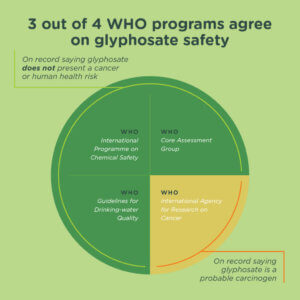
Dozens of independent agencies from around the world concur with Monsanto’s assessment of the overwhelming consensus evidence that glyphosate is not carcinogenic. While three WHO agencies have issued reports concluding that glyphosate is safe as used, IARC, alone, issued a monograph that declared glyphosate a “probable human carcinogen” when used by agricultural workers. Note that the agency did not say glyphosate was a ‘probable human carcinogen’ in trace amounts in food or that it posed any genuine risks.
Why is there such a discrepancy between the IARC hazard findings and risk assessments of the regulatory and mainstream science communities? Many people misunderstand how IARC and its findings are perceived in the global regulatory framework. For more than 40 years, the agency has assessed 989 substances and activities, ranging from arsenic to sunbathing and hairdressing; it designated only one as “probably not” likely to cause cancer in humans. Scientists and regulators are increasingly pushing back against what they say is a useless ‘hazard’ exercise, as almost any substance can be judged toxic, even water, if the ‘dose’ is extreme and the exposure time is long enough.
Most scientists believe IARC’s hazard assessments are confusing to the public and the science community, and offer conflicting regulatory guidance. Tim Pastoor, a consulting scientist for the agribusiness industry who testified at the hearings, noted the farcical categorization of some of hazard assessments issued by IARC. Plutonium is in the same risk category as salted meat and aloe vera is as ‘dangerous’ as gasoline. Glyphosate is considered as hazardous as grapefruit juice.
Not one independent regulatory agency has echoed IARC’s controversial conclusions. Every scientific, regulatory, or health body that has independently reviewed the voluminous literature on glyphosate’s toxicity has declared that the herbicide is safe when used according to its label––except IARC. There are hundreds of studies showing that glyphosate isn’t harmful as used.
Most recently, a November 2017 study published by the National Cancer Institute (NCI) echoed the FAO/WHO conclusion, finding “…no association was apparent between glyphosate and any solid tumors or lymphoid malignancies overall, including NHL and its subtypes.” The NCI paper came as a blow to USRTK’s campaign because it included the previously unpublished data from the Agricultural Health Study that Blair withheld from IARC, health outcomes from “…tens of thousands of agricultural workers, farmers and their families in Iowa and North Carolina,” according to The Washington Post.
An important point to stress is that most scientists in this field have no relationship with industry. According to a 2015 Nature Biotechnology paper, almost 60% of studies investigating GM crops “…have no financial or professional [conflicts of interest], as the authors were not affiliated with companies that develop GM crops…” This is significant because USRTK’s conspiracy theory, repeated at the hearing by the NRDC’s Jennifer Sass, assumes that Monsanto suppressed studies about the dangers of glyphosate exposure to protect the “billions of dollars” they make each year from selling the herbicide and herbicide-tolerant Roundup Ready seeds.
Ghostwriting
One of the charges made by USRTK and repeated at the hearing by the NRDC’s Sass isthat Monsanto ghost wrote several scientific review papers and at least one op-ed that appeared in the popular press and were intended to vindicate glyphosate. The basis for this claim is a series of emails between company scientists and independent biologist Dr. Henry Miller, a fellow at Stanford University’s Hoover Institution and a former FDA medical reviewer. Miller did incorporate some of Monsanto’s wording in some articles he wrote, but this falls far short of a smoking gun indicting all journalists, or indeed even Miller, who has a history of excellent reporting in this area. Yet, this is USRTK’s supposed smoking gun that Monsanto orchestrated a conspiracy to conceal the health risks linked to glyphosate. Gillam complained that such “corporate-spun science should not be guiding policy.”
The European Food Safety Authority reviewed the claims in the Monsanto Papers, saying that it was irrelevant whether Monsanto contributed to the writing of four glyphosate review papers, concluding “…that even if the allegations were confirmed…there would be no impact on the overall EU assessment and conclusions on glyphosate (p 1).” The EFSA noted that it was aware of Monsanto’s involvement, which it considered in preparing its evaluation:
……[Monsanto’s Involvement] was evident from the Declarations of Interest and Acknowledgements in the papers themselves…This means that Member State and EFSA experts were under no illusion about the links between the study authors and the companies that funded or facilitated their work when the experts carried out the risk assessment. (p 5).
The real glyphosate conspiracy?
The ironic part of this affair is that USRTK and IARC may be guilty of the malfeasance they accuse Monsanto of. In The Monsanto Papers the plaintiffs’ attorneys argued, “[u]nlike regulatory bodies that often have ties to industry and are shackled with earlier regulatory decisions, IARC is independent (p 9).” They didn’t mention (and it was obviously not mentioned by Sass in her testimony) that these same plaintiff’s lawyers had hired 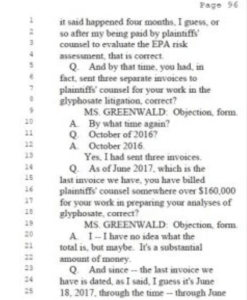 biostatistician and IARC advisory scientist Dr. Christopher Portier to consult with them as they prepared to sue Monsanto.
biostatistician and IARC advisory scientist Dr. Christopher Portier to consult with them as they prepared to sue Monsanto.
Portier, agreeed to be paid $160,000 even before the IARC monograph, which is the basis of their lawsuit, was released. Portier’s contract with these law firms was signed the same week IARC published its monograph. Portier admitted to this conflict of interest in his deposition in the Monsanto Papers.
The press also has been awash in reports that IARC deliberately excluded studies that didn’t fit the panel’s conclusion, which makes it appear predetermined. It should be noted that IARC does no research, it only reviews published research that it deems relevant, so if key studies were omitted the agency’s conclusions are already somewhat suspect.
IARC has refused to cooperate with Congress trying to get to the bottom of this controversy. In a reply to the Committee’s request for information about the Monograph Program in January 2018, IARC Director Chris Wild wrote that he would “…respond to further questions you may have about…glyphosate,” but declined to share IARC’s internal communications about the glyphosate monograph.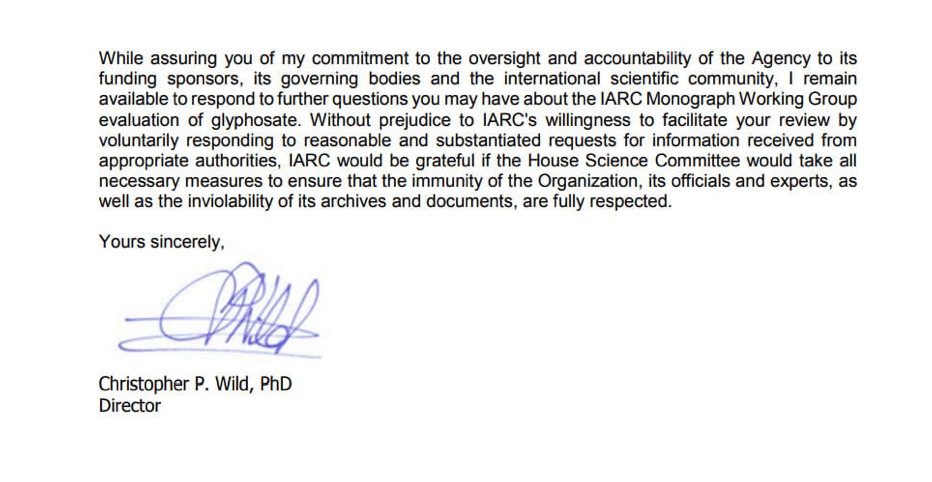
The battle over IARC comes against a backdrop of several years of growing ideological partisan acrimony over science, as the parties have frequently accused each other of being “anti-science.”
Monsanto, which is in the process of being acquired by Bayer, said after the hearing that IARC’s findings are an outlier when compared to what scores of other studies and regulators around the world have found.
“We’re pleased that serious questions are being asked about the discredited IARC opinion and the real harm it is causing to American farmers,” said Scott Partridge, Monsanto’s vice president of global strategy.
Sass was dismissive. “Are we willing to sell out the public’s right to know about harmful chemicals in the places we work live, and play, just so that Monsanto Co. can sell more glyphosate?” she said.
Jon Entine, executive director of the Genetic Literacy Project, has been a journalist for more than 40 years, as a writer, network television news producer and author of seven books, four on genetics and risk. BIO. Follow him on Twitter @JonEntine.
Cameron English is a freelance science writer and podcast host. He covers nutrition, public health, biotechnology and occasionally other topics. Visit his website and follow him on Twitter @camwritessogood.

